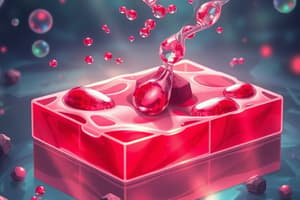Podcast
Questions and Answers
What is the purpose of wearing safety goggles when carrying out chemical tests for carbohydrates, proteins, and lipids?
What is the purpose of wearing safety goggles when carrying out chemical tests for carbohydrates, proteins, and lipids?
- To comply with school safety regulations, regardless of the chemicals used
- To avoid getting chemical solutions on the face during the experiments
- To look more professional in the lab environment
- To prevent eye injury from the hazardous chemicals used in the tests (correct)
Which color change indicates the presence of starch when testing for carbohydrates using iodine solution?
Which color change indicates the presence of starch when testing for carbohydrates using iodine solution?
- Green
- Yellow
- Red
- Blue-black (correct)
What is the purpose of using Benedict solution when testing for sugars like glucose?
What is the purpose of using Benedict solution when testing for sugars like glucose?
- To create a color change that indicates the presence of proteins
- To create a color change that indicates the presence of lipids
- To create a color change that indicates the presence and amount of sugars (correct)
- To create a color change that indicates the presence of starch
What is the purpose of the Biuret test when testing for proteins?
What is the purpose of the Biuret test when testing for proteins?
What is the purpose of adding ethanol to a food solution when testing for lipids?
What is the purpose of adding ethanol to a food solution when testing for lipids?
Study Notes
- Chemical tests for carbohydrates, proteins, and lipids are part of a required practical in science labs.
- Safety goggles must be worn when carrying out these tests due to the hazardous nature of the chemicals involved.
- Carbohydrates can be tested for starch using iodine solution, where a color change to blue-black indicates the presence of starch.
- Testing for sugars like glucose involves using Benedict solution, with colors like green, yellow, and brick red indicating different sugar amounts.
- Proteins can be tested using Biuret solution, where a color change from blue to purple or lilac indicates the presence of proteins.
- Lipids can be tested by creating a white cloudy emulsion when adding ethanol to the food solution, without the need for filtration.
Studying That Suits You
Use AI to generate personalized quizzes and flashcards to suit your learning preferences.
Description
Learn about the required practical in science labs involving tests for carbohydrates (starch and sugars), proteins, and lipids with specific chemical reagents. Understand the safety precautions, color changes indicating the presence of different macromolecules, and the procedures for conducting these tests.




